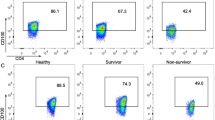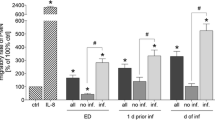Abstract
Objective
To study the influence of sera from severely injured patients on the human leukocyte antigen (HLA)-DR expression of normal peripheral blood mononuclear cells (PBMC).
Design
In vitro study.
Setting
University hospital.
Patients and participants
Sera from 34 patients were obtained within 8 h after trauma. Seventeen of these patients developed posttraumatic sepsis (sepsis group) and 17 recovered without infectious complications. Sera from ten healthy individuals served as controls. Phytohemagglutinin (PHA)-activated PBMC from 44 healthy donors were used to study the effects of a patient's serum.
Measurements and results
Medium containing 5% of serum from the sepsis group significantly (p<0.05) reduced the HLA-DR expression (channels, mean ± standard error of the mean) on monocytes (patients 883±22, controls 962±15), B (patients 922±14, controls 972±7) and T cells (patients 932±13, controls 968±5) of PHA-activated PBMC. Significantly increased accumulation of TNFα on (1.8±0.4% of PBMC) and within T cells (0.98±0.26% of PBMC) was observed by flow cytometry after incubation with medium containing sera of the sepsis group compared with controls (on 0.5±0.1%, within 0.27±0.05% of PBMC). A significant negative correlation between relative cell counts of intracellular TNFα-positive T cells with HLA-DR expression was observed for monocytes (r= −0.61), B cells (r= −0.57) and proliferation (r= −0.68) as estimated by 3H-thymidine uptake [patients 139,971±12,844 counts per minute (cpm), controls 198,973±19,347 cpm, p<0.05] in the presence of sera from the sepsis group.
Conclusions
Reduced cellular immunity and, therefore, immunodeficiency after trauma appears to be caused by soluble factors influencing T cell function in particular.


Similar content being viewed by others
References
Mach B, Steimle V, Martinez-Soria E, Reith W (1994) Regulation of MHC class II genes: lessons from a disease. Annu Rev Immunol 14:301–331
Botazzo GF, Pujol-Borrell R, Hanafusa T, Feldmann M (1983) Role of aberrant HLA-DR expression and antigen presentation in induction of endocrine autoimmunity. Lancet 2:1115–1119
Goris RJA, Draaisma J (1982) Causes of death after blunt trauma. J Trauma 22:141–146
Centers for Disease Control (1990) Increase in national hospital discharge survey rates for septicemia—United States, 1979–1987. JAMA 263:937–938
Cheadle WG, Hershman MJ, Wellhausen SR, Davidson PF, Polk HC Jr (1991) HLA-DR antigen expression on peripheral blood monocytes correlates with surgical infection. Am J Surg 161:639–645
Wakefield CH, Carey PD, Foulds S, Monson JRT, Guillou PJ (1993) Changes in major histocompatibility complex II expression in monocytes and T cells of patients developing infection after surgery. Br J Surg 80:205–209
Ditschkowski M, Kreuzfelder E, Majetschak M, Obertacke U, Schade FU, Grosse-Wilde H (1999) Reduced B cell HLA-DR expression and natural killer cell counts in patients prone to sepsis after injury. Eur J Surg 165:1129–1133
Ditschkowski M, Kreuzfelder E, Rebmann V, Ferencik S, Majetschak M, Schmid E, Obertacke U, Hirche H, Schade FU, Grosse-Wilde H (1999) HLA-DR expression and soluble HLA-DR levels in septic patients after trauma. Ann Surg 299:246–254
Majetschak M, Flach R, Heukamp T, Jennissen V, Obertacke U, Neudeck F, Schmit-Neuerburg KP, Schade FU (1997) Regulation of whole blood tumor necrosis factor production upon endotoxin stimulation after severe blunt trauma. J Trauma 43:880–887
Majetschak M, Börgermann J, Waydhas C, Obertacke U, Nast-Kolb D, Schade FU (2000) Whole blood tumor necrosis-alpha production and its relation to systemic concentrations of interleukin 4, interleukin 10 and transforming growth factor-beta1 in multiply injured blunt trauma patients. Crit Care Med 28:1847–1853
Baker SP, O´Neill B, Haddon W, Long WB (1974) The injury severity score: a method for describing patients with multiple injuries and evaluating emergency care. J Trauma 14:187–196
American College of Chest Physicians/Society of Critical Care Medicine consensus conference (1992) Definitions for sepsis and organ failure and guidelines for the use of innovative therapies in sepsis. Crit Care Med 20:864–874
Maschke J, Menne S, Jacob JR, Kreuzfelder E, Tennant BC, Roggendorf M, Grosse-Wilde H (2001) Thymidine utilization abnormality in proliferating lymphocytes and hepatocytes of the woodchuck. Vet Immunol Immunopathol 78:279–296
Fumeaux T, Pugin J (2002) Role of interleukin-10 in the intracellular sequestration of human leukocyte antigen-DR in monocytes during septic shock. Am J Respir Crit Care Med 166:1475–1489
Bone RC (1996) Sir Issaac Newton, sepsis, SIRS and CARS. Crit Care Med 24:1125–1128
Munford RS, Pugin J (2001) Normal responses to injury prevent systemic inflammation and can be immunosuppressive. Am J Respir Crit Care Med 163:316–321
Benoist C, Mathis D (1990) Regulation of major histocompatibility complex class II genes: X, Y and other letters of the alphabet. Annu Rev Immunol 8:681–715
Glimcher LH, Kara CJ (1992) Sequences and factors: a guide to MHC class II transcription. Annu Rev Immunol 10:13–49
Dufour C, Corcione A, Svahn J, Haupt R, Battilana N, Pistoia V (2001) Interferon γ and tumour necrosis factor α are overexpressed in bone marrow T lymphocytes from paediatric patients with aplastic anaemia. Br J Haematol 115:1023–1031
Bo X, Broome U, Remberger M, Sumitran-Holgersson S (2001) Tumour necrosis factor alpha impairs function of liver derived lymphocytes and natural killer cells in patients with primary sclerosing cholangitis. Gut 49:131–141
Takahashi K, Takigawa M, Arai H, Kurihara H, Murayama Y (1994) The inhibition of interferon-gamma-induced upregulation of HLA-DR expression on cultured human gingival fibroblasts by interleukin-1 beta or tumor necrosis factor-alpha. J Peridontol 65:336–341
Konig, A, Happle, R, Hoffmann, R (1997) IFN-gamma-induced HLA-DR but not ICAM-1 expression on cultured dermal papilla cells is downregulated by TNF-alpha. Arch Dermatol Res 289:466–470
Watanabe Y, Jacob CO (1991) Regulation of MHC class II antigen expression. Opposing effects of tumor necrosis factor-alpha on IFN-gamma-induced HLA-DR and Ia expression depends on the maturation and differentiation stage of the cell. J Immunol 146:899–905
Yoshimoto, T, Takeda, K, Tanaka, Z, Ohkusu, K, Kashiwamura, S, Okamura, H, Akira, S, Nakanishi, K (1998) IL-12 up-regulates IL-18 receptor expression on T cells, TH 1 cells and B cells: synergism with IL-18 for IFN γ production. J Immunol 161:3400–3407
Davis, GS, Pfeiffer, LM, Hemenway, DR (2000) Interferon-γ production by specific lung lymphocyte phenotypes in silicosis in mice. Am J Respir Cell Mol Biol 22:491–501
Dustin ML (2002) Membrane domains and the immunological synapse: keeping T cells resting and ready. J Clin Invest 109:155–160
Acknowledgements
We wish to thank Dr. H. Ottinger for his assistance in establishing the method for intracellular cytokine staining.
Author information
Authors and Affiliations
Corresponding author
Rights and permissions
About this article
Cite this article
Mueller, A., Kreuzfelder, E., Nyadu, B. et al. Human leukocyte antigen-DR expression in peripheral blood mononuclear cells from healthy donors influenced by the sera of injured patients prone to severe sepsis. Intensive Care Med 29, 2285–2290 (2003). https://doi.org/10.1007/s00134-003-1992-8
Received:
Accepted:
Published:
Issue Date:
DOI: https://doi.org/10.1007/s00134-003-1992-8




